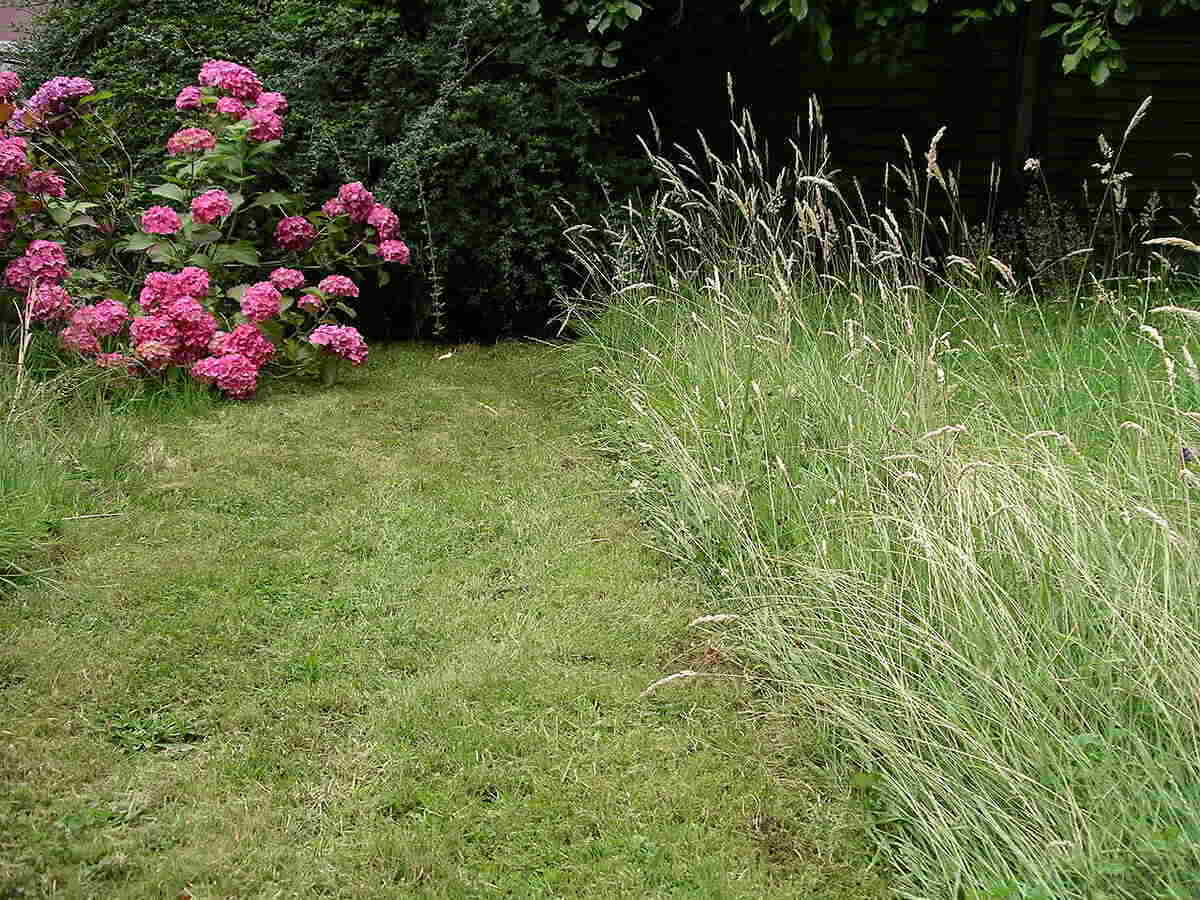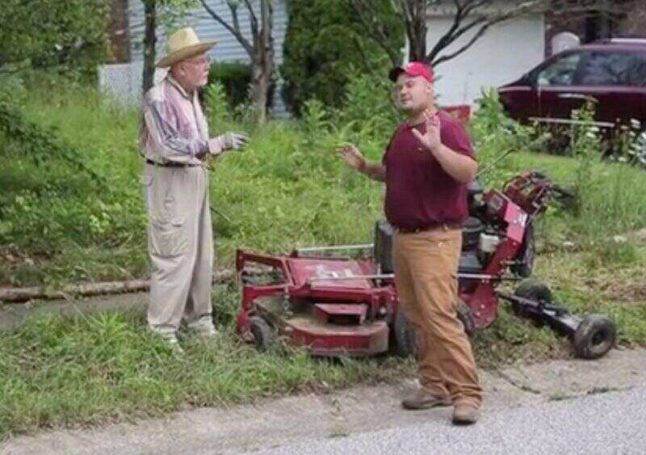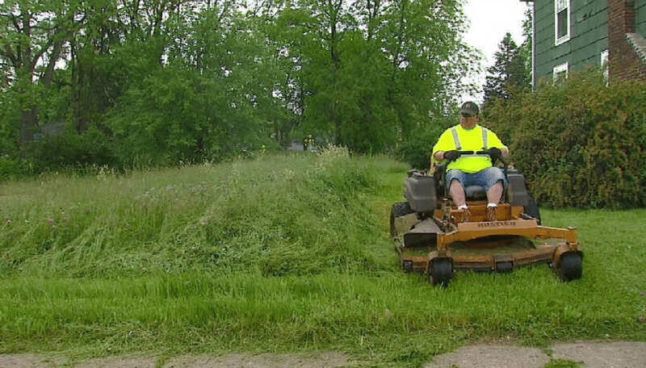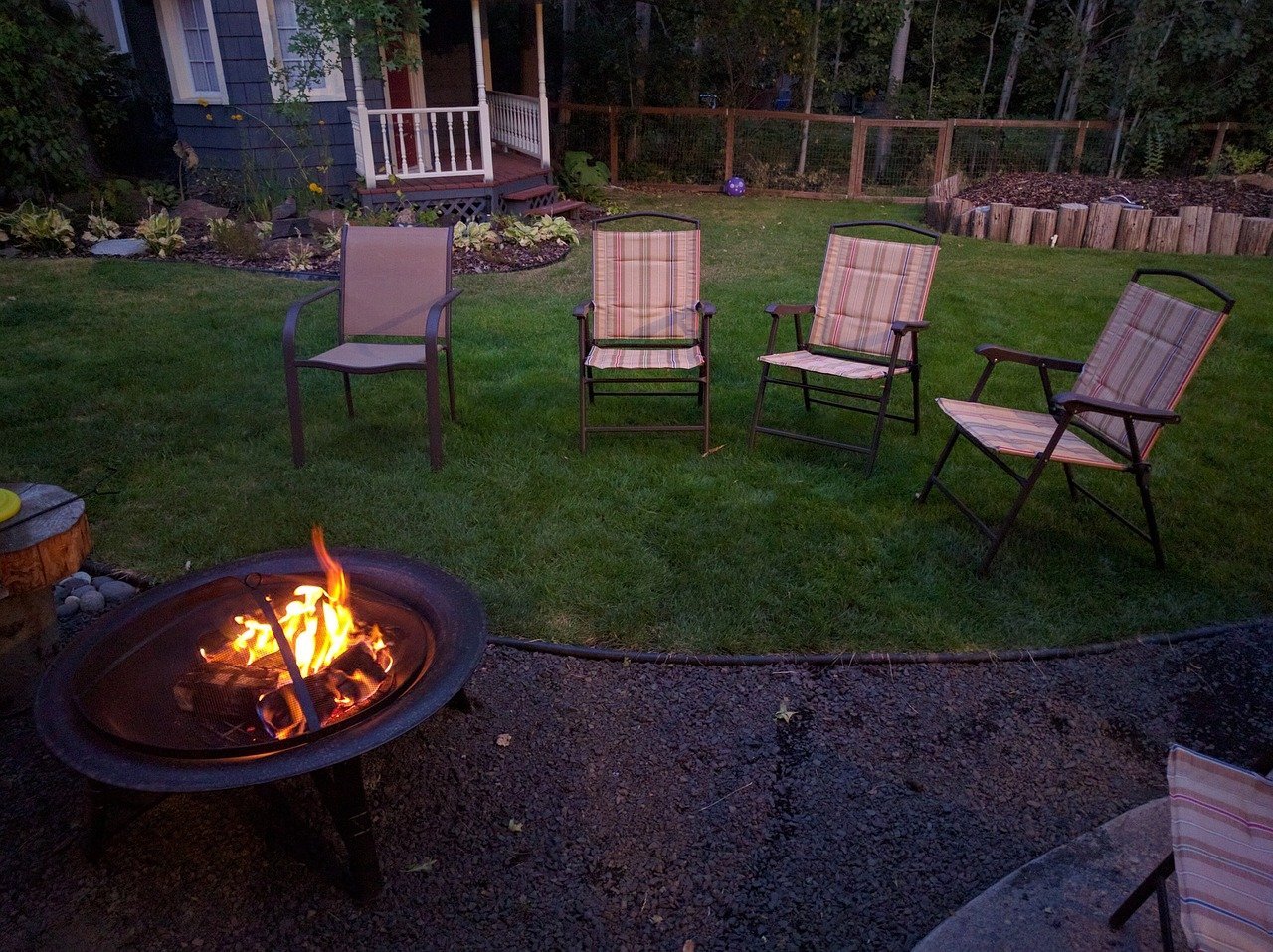
There are practical, financial and legal consequences if you don’t mow your lawn as required by local ordinances or homeowners’ association covenants. You could be fined. A lien could be placed on your property. In extreme cases, you could be foreclosed on or even go to jail.
- Not Mowing Leads to Fines
- Rules Often Say Mow, Or Else
- Why ‘Mow It’ Laws Are Legal
- Homeowners’ Objections Overruled
- The Right To Not Grow Grass At All
- Homeowners’ Association Rules
- Mowing Requirements, Code Enforcement Not All Cut And Dry
- Warnings Then Forced Mowings
- Vacant Properties Often The Culprits
- Grass Too Long? Two Cuts, Experts Say
- Going No-Mow
- No-Mow, No-Grass Legal Battles Rage On
- FAQ: What Can Happen If You Refuse To Mow Your Lawn
Not Mowing Leads to Fines
Some people can’t wait to wake up on a Saturday, fire up the lawnmower, and take great pride in a beautifully cut lawn.
Alexander Gul of Bloomington, Indiana, isn’t one of those people.
A lover of freedom and fervent opponent of synthetic fertilizers, he disobeyed a city ordinance that limits grass height to 8 inches. In the process, he got an expensive and ongoing lesson on what happens if you refuse to mow your lawn.
He told LawnStarter.com he spent “at least $15,000” fighting the city’s escalating fines and a lawsuit that went to the state’s appeals court, where he lost in a unanimous but sympathetic 3-0 ruling.
Gul even stood toe-to-blade in front of a running power mower the city hired and forced the mower to stand down. “Why would I be afraid?” he said.
Wait, you may be saying. Don’t I have the right to do what I want with my own property? What gives anyone the right to force me to mow? The short answers are “no,” and, “the law.” But here are the fuller answers to those questions about what can happen if you heed the call of the wild and refuse — or just forget — to mow your grass.
Rules Often Say Mow, Or Else
Many neighborhoods and local jurisdictions around the country have laws in place that can carry steep fines or worse for property owners who fail to keep up with their lawns.
Nuisance ordinances are the main way cities or counties make sure residents are maintaining their properties.
These ordinances govern anything that “amounts to an unreasonable interference with the health, safety, morals or comfort of the community,” writes Trey Allen, assistant professor of public law and government of the University of North Carolina School of Government.
The most common, he explains, are ordinances that pertain to property management and upkeep, especially “minimum maintenance requirements on residential or commercial lots.”
“A lot of times, especially in court cases, the benefit to the community is that it keeps things like rodents and snakes from taking up homes in the neighborhood,” said Brian Burgess, planner for the Town of Mills River, North Carolina, who has worked at the county and city level over the past several years.
If you break those laws, even unintentionally, you could be in peril.
A Dunedin, Florida, man found that out the hard way. Jim Ficken, 69, was out of town tending his late mother’s estate in 2018. The handyman he hired to mow his lawn during his absence also died, and the grass exceeded the city’s 8-inch height restriction.
Unknown to Finken, he was racking up fines of $500 per day. The fines reached $29,000 and the city attempted to foreclose on his house. At the end of April 2021, a federal judge ruled that Finken must pay the fines, but he isn’t giving up and plans to appeal.
“It’s just ridiculous to be allowed to run up fines for such excessive amounts for something as minor as tall grass,” Finken told WFTS Tampa Bay.
Why ‘Mow It’ Laws Are Legal
Individuals have challenged governmental units over the power to force you to mow. It usually hasn’t gone well for the individuals. While there have been some lower-court victories, at higher levels, courts have consistently sided with the government’s right to force you to mow your lawn.
Court challenges over the years have defined property rights as substantial, but not absolute. Just as you can’t cite First Amendment protection for shouting “fire” in a crowded building, you can’t let your grass grow to 9 inches in Elroy, Wisconsin.
One court case that made “mow it” laws legal is the 1954 United States Supreme Court decision in Berman v. Parker. It established the legal principle of “eminent domain” — that governments can take private property if it gives just compensation.
The ruling also provided some legal underpinning for mowing regulations: “It is within the power of the legislature to determine that the community should be beautiful.”
Governments may define “beautiful” as grass cut short, the court has also found, if there is a connection between a cut lawn and citizens’ health and safety.
Lower courts have continued to defer to government regulations in more recent rulings.
Homeowners’ Objections Overruled
In 2015, the U.S. District 6th Court of Appeals sided with the city of Howell, Michigan, and required homeowner David Shoemaker to mow a grassy strip near the road by his house.
Shoemaker likened forced mowing to the actions of totalitarian governments, and argued the ordinance “makes the City look like North Korea rather than an American city.”
No, the court said, the city’s right to place reasonable aesthetic demands renders “the mowing burden placed upon him constitutionally acceptable.”

In Gul’s 2014 case, the court credited him for his sincere belief that “modern-day lawn maintenance practices are harmful to the environment.”
But the court cut through Gul’s arguments.
“Gul’s belief regarding the environmental harm of modern-day lawn care is undisputedly sincerely held. But it is not a religious belief. And even though he has the right to hold this belief [it] does not protect him from legal consequences if he violates local ordinances in the name of this belief.”
Appeals Court Judge Valeri Haughton wrote the opinion on the court’s 3-0 rejection of Gul’s arguments. She tipped which way the court decided in the opening lines of the 16-page opinion. “The grass may be greener on the other side of the fence,” she wrote, “but you still have to mow it.”
The Right To Not Grow Grass At All
Another grass-mandate case winding through legal channels takes a different tack. Janice Duffner of St. Peters, Missouri, is allergic to grass, but the St. Louis suburb where she lives has an ordinance that requires properties’ lawn areas to contain 50% grass.
She refused, In place of grass, she planted neatly trimmed roses and other flowers, and eventually sued, saying the city’s ordinance violated her constitutional property right — the right to not grow grass.

“This is the first case in the history of the United States we have found where the government is saying ‘You own this property, therefore you must use it in the way we command,’” said her attorney, Dave Roland of the Freedom Center of Missouri.
“We argued that if the property use itself is perfectly lawful, they have a fundamental right to use the property in the way they see fit, instead of kowtowing to the government’s command,” Roland added, “If anything the turfgrass requirement runs contrary to public health and safety since it causes Jan Duffner to get sick.”
Were the law to be fully enforced, Roland said, Duffner could be facing up to $400,000 in fines and 40 years in jail. Fortunately for the Duffners, the city of St. Peters has decided not to force them to replace their plants with turf.
Homeowners’ Association Rules
While they don’t have the color of law behind them, homeowners’ associations (HOAs) can also have stiff rules dictating grass height, and often go further than the rules of your local government.
Their right to force you to mow is contained within the Covenants, Conditions and Restrictions (CC&R) documents. Owners in HOA communities all sign contracts when they purchase property promising to abide by the CC&R. If you violate the rules, you’re not breaking the law, but the consequences can be just as severe.
In communities with stricter guidelines, Burgess said, it’s often justified as a way to make sure the property matches the character of the neighborhood.
Penalties for violations can include:
- Fines
- Loss or suspension of community privileges, such as the use of the pool
- Forced compliance (as in calling in a mower and billing you for it)
- Lawsuits
The continuing violation of CC&Rs can even lead to foreclosure.
Mowing Requirements, Code Enforcement Not All Cut And Dry
Nuisance ordinances can vary, with county rules generally laxer than cities’. Using Wichita, Kansas, as an example, the city code allows for grass to be no more than 12 inches high, but Sedgwick County, where Wichita is located, allows grass to grow no more than 18 inches high.
Burgess notes that an average length when ordinances kick in is usually 24 inches, though they range anywhere from 12 to 36.
Cincinnati charges $500, though that will be cut in half once the lawn is mowed, and if the homeowner lives at the property and it’s their first offense, the fine can be waived altogether.
In North Carolina, cities can charge anywhere from $175 to $500 for noncompliance.
Warnings Then Forced Mowings
Fines aren’t the only kind of code enforcement that municipalities or counties can use to make sure you keep your lawn tidy.
In High Point, North Carolina, if a homeowner’s lawn is unkempt the city will post a warning in the yard itself. If there’s no response the city will mail a letter and if the grass isn’t cut a month after an inspector checks it out, the city will place a lien on the home.
Cities with their own public works department will usually just send a crew out to cut the grass and then charge the homeowner, Burgess explained. When you add in fines and a surcharge that cities often charge for code violations, it’s likely to be the most expensive haircut your lawn has ever had.
Vacant Properties Often The Culprits
Nine out of 10 times, Burgess said, the too-high grass is on a vacant property like a leased property where the owners are out of town and forgot to arrange for the lawn to be mowed. The owner is not really trying to be a nuisance.
Most homeowners who reasonably maintain their lawns have nothing to fear. Many nuisance ordinances are complaint-driven, meaning there are no Grass Inspector Patrol cars trolling the neighborhood, looking for offending lawns. Officials check out a site only when a neighbor calls to complain.
Once cited, there’s usually a grace period of at least a week to allow the nuisance to be abated, meaning if the grass is cut down to within the maximum allowable length in that time, any penalty will be avoided.

Grass Too Long? Two Cuts, Experts Say
So, say you do need to cut the front yard to avoid that hefty fine from the city. If you bring out the lawnmower and cut it down to a few inches all at once you may end up with another problem.
Experts say that mowing the lawn properly means cutting at most one-third of the grass’s height at a time to avoid doing extra damage to the plant itself. If your mower is set at 3 inches, for example, cut the grass before it reaches a height of 4-1/2 inches.
Cutting it all at once will result in scalping, or cutting the grass too low to the ground, leaving only the stem. This not only damages the plant’s health, it also leaves a brown eyesore.
Alternating mowing patterns and mowing more frequently at longer mowing heights can help make sure you don’t scalp your lawn.
Going No-Mow
A different option for a low-maintenance lawn that could still meet HOA and nuisance ordinance guidelines is a no-mow lawn, one that uses certain grass types to create a flowing grass cover that has longer blades but still maintains a tidy appearance.
According to Prairie Nursery, not mowing the lawn at all will result in a turf with leaves that grow to about 6 inches in height and drape over one another. They carry a specially designed No Mow Lawn Seed Mix that blends different fescue grasses for those who live in the right climate,
That forms “a low-growing meadow effect,” according to a fact sheet from the company, with the lawn maintaining a normal height of 5 to 6 inches.
You can even mow a no-mow lawn, in the spring and fall, or even more regularly. But never cut lower than about 3-1/2 inches.
Prairie Nursery, too, stresses to “never remove more than one-third of the total leaf material when mowing or the turf will be damaged.”
No-Mow, No-Grass Legal Battles Rage On
The legal cases continue for the right to not mow, or to eschew grass entirely.
Roland expects a ruling in the Duffner allergy case in Missouri any day. “If they just rule against us across the board, then our next step is to go to the Supreme Court,” he said.
Gul, having lost at the appeals court level, still fights the fight in his own way. He has periodically trimmed his grass plants with a scythe or clippers and brought it down to under the city’s 8-inch limit while doing his best to avoid cutting any other non grass plants.
The conflict drove him to a new extreme: Though he loathes common chemical lawn treatments, he’s trying one himself — Clethodim 2E. It kills grass.
“People cannot explain to me where I am wrong, where my logic is counterproductive or against society,” he says.
“Sure, the government will tell you that with mowing, higher prices of real estate will bring more taxes in our coffers. And they’ll say we need the money, and there never is enough money,” he adds. “We’ll end up with a planet full of chemicals because everything that is living will disappear.”
Bloomington cited Gul again this week.
FAQ: What Can Happen If You Refuse To Mow Your Lawn
Once a week during the growing season should be enough. You can mow every other week, if necessary, as it goes dormant for winter. Your mowing schedule may vary if:
•Recently fertilized: Causing a growth spurt
•Drought: Let grass grow higher to retain water
•Turf type: Different types of grass have different growing seasons. Cool-season lawns may go dormant in the summer. Where temps get cold in the winter, neither cool- nor warm-season lawns need mowing.
Yes. In Grand Prairie, Texas, a man was jailed for defying city orders to mow his lawn for almost 20 years. This is only one case, as others have also been arrested for violating local ordinances or HOA mandates.
Yes. Inform the homeowners’ association (HOA) or your local enforcement department for code violations.
If lawn care isn’t your thing, but you want to steer clear of the citation book, it might be best to bring in a local LawnStarter pro to help keep your lawn tidy and your checkbook safe.
Daniel Ray contributed to this report.
Main image credit: Snowmanradio / Wikimedia Commons / CC BY-SA 3.0




